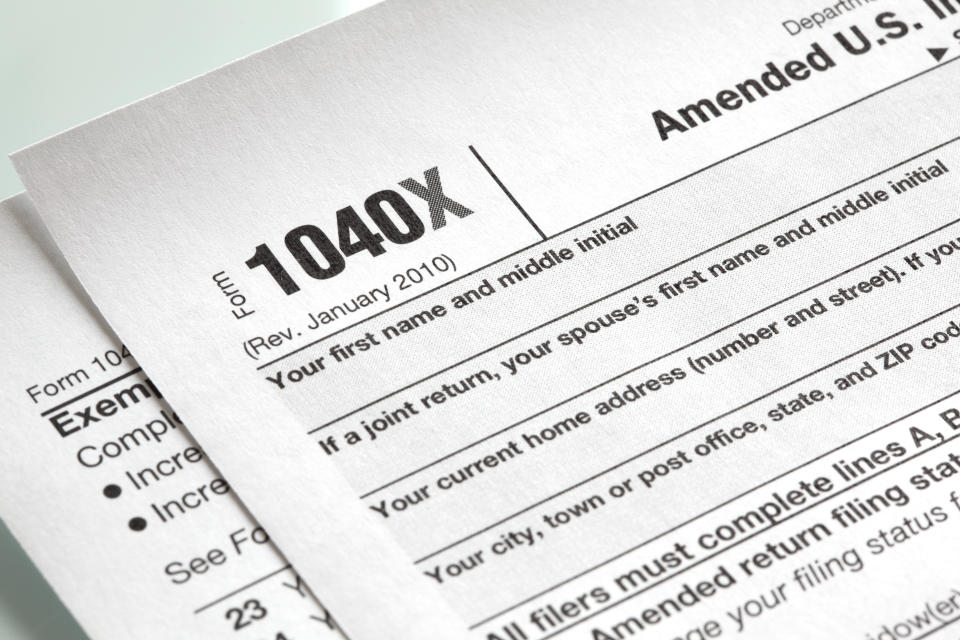Why you might want to redo part of last year’s taxes
Maybe you got your taxes out of the way already or you’re still dreading them before the April 15 deadline.
Either way, here’s a potential punch in the gut: You might want to revisit last year’s returns as well.
There are two reasons for this. First, recently-extended tax provisions that can be retroactively applied to your 2018 tax returns, which you filed last year, may be reason enough for some taxpayers to redo those taxes.
Other taxpayers may want to check to see if they missed two key changes from the 2017 Tax Cuts and Jobs Act when filing last year.
Read more: How to file taxes: The full breakdown

Extended tax provisions
Congress extended several temporary tax provisions in December 2019. These extensions retroactively apply to both 2019 and 2018 tax years. These provisions were not in effect when you filed your taxes last year.
Forgiveness of debt on principal residence: Typically, forgiven debt is considered taxable income. But this extender eliminates taxes a homeowner might face when their lender forgives or cancels some of their outstanding mortgage balance, especially when it comes to short sales and foreclosures.
“While only a small number of taxpayers experience that, it can have a really profound effect for them,” Kathy Pickering, chief tax officer of H&R Block, told Yahoo Money.
Deduction of private mortgage deduction: This allows homeowners to deduct premiums for private mortgage insurance and insurance on home loans backed by the Federal Housing Administration and Veterans Affairs. This extender is capped starting at $100,000 in income.
In 2017, the last time this extender was in effect, almost 2.3 million taxpayers took advantage of it, according to statistics from the Internal Revenue Service. This deduction can be worth up to $3,000 to $3,500, Pickering noted.
Energy efficiency improvements: This is a credit, worth up to $500, that homeowners can claim for certain energy-efficient upgrades.
Tuition and fees deduction: If you, your spouse or your child is in college, you can deduct up to $4,000 a year in tuition costs and expenses. You can take this above-the-line deduction even if you don’t itemize your taxes.

Missed tax law changes
Pass-through business deduction: The official guidance on this new deduction from the Trump Administration’s tax law came out on Jan. 18, 2019, just before last year’s tax season got underway. The delay in guidance may have caused many taxpayers to miss this lucrative deduction, Pickering said.
“Last year, 15.6 million filers took the qualified business deduction for $84 billion,” she said. “We expect to see a lot more people taking advantage of it this year.”
The deduction allows taxpayers who earn less than $157,500 (or $315,000 for married couples) to deduct 20% of the income from pass-through businesses – such as sole proprietorships, partnerships and S corporations – from their overall income. Those who exceed the income threshold and aren’t service professionals can still take the deduction if they meet specific requirements.
Other dependent credit: While there was plenty of hubbub around the doubling of the child tax credit last year, Pickering said taxpayers may have missed the nonrefundable dependent care credit worth up to $500.
You can take this if you provided more than half of the financial support for a child who is 17 or older, a relative, or a non-relative who lived with you the entire year. To qualify, the non-child dependent must have made less than $4,150 or more in gross income that year. The deduction begins to phase out at $200,000 in adjusted gross income ($400,000 for joint filers).
How to refile your taxes
Unfortunately, you have to file your taxes the old-fashioned way – on paper – if you want to amend a previous year’s return. You can’t amend a return electronically.
Use Form 1040-X, Amended U.S. Individual Income Tax Return, to correct errors on an original return you already filed, such as filing status, the number of dependents, total income, deductions, or credits.

Make sure to check a box at the top of the form to indicate which year you’re amending. Explain what you’re changing and why on the second page of the 1040-X. If you make any changes to another tax form or schedule, attach those to your 1040-X when filing to avoid a delay in processing.
If you owe more tax after amending your return, pay the IRS as soon as possible to limit interest and penalty fees.
Mail Form 1040-X to the address listed in its instructions. You have three years to file an amended tax return. You can track the status of your amended return at “Where’s My Amended Return?” on the IRS website.
Janna is an editor for Yahoo Money and Cashay. Follow her on Twitter @JannaHerron.
Read more:
Follow Yahoo Finance on Twitter, Facebook, Instagram, Flipboard, SmartNews, LinkedIn, YouTube, and reddit.

 money
money 
